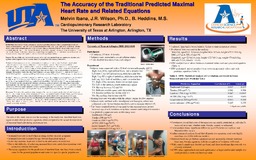
ATTENTION: The works hosted here are being migrated to a new repository that will consolidate resources, improve discoverability, and better show UTA's research impact on the global community. We will update authors as the migration progresses. Please see MavMatrix for more information.
Show simple item record
| dc.contributor.author | Ibana, Melvin | en_US |
| dc.date.accessioned | 2013-02-19T17:05:25Z | en_US |
| dc.date.available | 2013-02-19T17:05:25Z | en_US |
| dc.date.issued | 2013-02-19 | en_US |
| dc.identifier.uri | http://hdl.handle.net/10106/11331 | en_US |
| dc.description.abstract | Most aerobic exercise programs are based on a percentage of an individual’s maximal heart or heart rate reserve, of which maximal heart rate is a component. Maximal heart rate is the highest heart rate achieved by an individual while working at their maximal intensity, usually to fatigue. Maximal heart rate is related to an individual’s age but is not completely dependent upon it. But there are risks that come with exercising maximally and some people do not want to put forth the effort; hence, prediction equations were created. Numerous equations for the prediction of maximal heart rate have been created, some for general population and some for specific special populations. | en_US |
| dc.description.sponsorship | Wilson, Judy, Ph.D. | en_US |
| dc.description.sponsorship | Heddins, Brad, M.S. | en_US |
| dc.language.iso | en_US | en_US |
| dc.subject | heart rate reserve | en_US |
| dc.subject | maximal heart rate | en_US |
| dc.subject | predictive equations | en_US |
| dc.title | The accuracy of the traditional predicted maximal heart rate and related equations | en_US |
| dc.type | Presentation | en_US |
| dc.publisher.department | Cardiopulmonary Research Laboratory, The University of Texas at Arlington | en_US |
| dc.publisher.department | Exercise Science Research Laboratories, The University of Texas at Arlington | en_US |
| dc.publisher.department | Department of Kinesiology, The University of Texas at Arlington | en_US |
Files in this item
- Name:
- Ibana heart rate poster.pdf
- Size:
- 1.860Mb
- Format:
- PDF
- Description:
- PDF
This item appears in the following Collection(s)
Show simple item record


